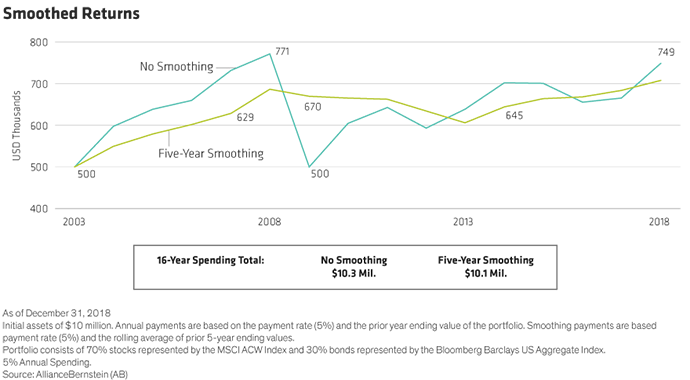Bouts of volatility in equity markets should serve as a wake-up call for investment committees. Not only do fiduciaries need to review their investment policy statement and question their policies, but they should consider other strategies to handle extreme market stress. Fortunately, they have several tools at their disposal. Here are a few.
All for One, But Not One for All
Not all assets are the same. But often, they are managed in one pool as if they had one purpose with the same time horizon. This strategy tends to result in a moderate growth portfolio strategy. Unfortunately, this strategy is all wrong—it’s too aggressive for assets needed in the next few months, and too conservative for those not needed for decades. A better solution?
Investment committees should partner with the executive finance team to determine how much of the total asset pool is needed in the near term (within 1 year) and intermediate period (2–5 years), deeming the remainder as long-horizon. Especially in an era when portfolios will have to work harder than historically to achieve needed returns, segregation enables portfolios to take on appropriate levels of risk, perhaps adding illiquidity, to optimally position the aggregate portfolio to achieve its long-term return target.
A Strategic Game Plan
Although the strategic allocation policy sets the asset allocation for the investment portfolio, it is also a very powerful tool in times of stress. Investment committees dedicate a significant amount of time and employ analytical rigor developing their strategic allocation, and rightly so. Based on specific parameters and expectations around a “normal” market environment, strategic allocations are designed to provide a certain level of expected return. Unfortunately, as we saw in late 2018, the financial markets do not always cater to our ideal framework, and the conventional mix of stocks and bonds may not return what they had in the past.
By relying on the traditional allocation models—the conventional 60:40 portfolio—committees are missing one of the most important tools available to them: diversifying alternative strategies with varying degrees of illiquidity and low correlations to traditional stocks and bonds.
Diversifying strategies—private equity, hedge funds, and real estate, for example—deliver a pattern of returns that tend to differ from that of public equities, actively diversifying public-equity performance. In other words, when public equity markets rise or fall, private investments tend to continue on their path, generally unaffected by the market moves. They can also play a critical role in a fixed income portfolio; in a low interest rate environment, private credit can complement traditional bonds by improving returns and reducing interest rate risk. But an asset allocation that includes alternative investments, must account for their unique risks—illiquidity in particular—to ensure the ability to spend from a portfolio is not in peril, while tolerating drift from the initial target allocation since rebalancing a portfolio that includes illiquid investments is difficult.
Planning Tactics
While the optimal strategic allocation should pan out in the long run, short-term market disruptions—ones that last months or even a year- can derail even the best laid plans. That’s where tactical allocation comes into play.
Organizations also need to establish parameters and processes for managing short-term adjustments to their long-term strategic portfolio allocations. While a fully diversified, long-term strategic allocation is key to governance and prudent oversight of assets, tactical adjustments can be used to manage short-term volatility.
Think about it this way: Strategic allocation establishes the risk budget of a portfolio; tactical allocation tries to keep the portfolio as close to that risk budget as possible by dynamically adjusting portfolio weights as market conditions change. Even though the long-term volatility of the market over the last 20 years has been quite low, during that same period, volatility oscillated between periods well above the long-term average, something we saw in 2007–2010 when the standard deviation of returns exceeded 20%, and periods where volatility was surprisingly low, like in 2017. Having a well-defined process for making adjustments and monitoring their impact can smooth returns.
Smooth Execution
A smoothing policy can improve consistency of distributions, even with the optimal asset allocation, without sacrificing longevity. Smoothing—which sets annual spending as a percentage of the average of several years’ asset values rather than just one year’s—will generally help nonprofits strike the right balance between spending and preserving assets. By employing this strategy, the rate of spending increases slow during up markets and helps maintain spending through down markets. Smoothing also facilitates a more aggressive risk/return profile for the investment portfolios of nonprofits because as long as the organization can tolerate portfolio volatility, spending volatility will be greatly reduced.

A Winning Formula
No single tool can ward off market volatility on its own, but a combination of tactics can effectively combat risk. The key is to establish the proper strategy by segmenting assets, structuring allocation for the long term using a combination of traditional and alternative asset classes, allowing for tactical moves, and instituting a smoothing policy. The confluence of these can help a committee block and tackle during a shifting environment.
For more on timely topics for nonprofits, explore “Inspired Investing”, a new Bernstein podcast series that covers investing, spending, policy and more for Endowments & Foundations, and for additional thought leadership, check out the related blogs here.
- Clare Golla
- National Managing Director—Philanthropic Services
- Travis Allen
- Managing Director

